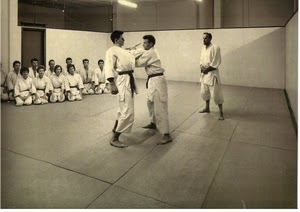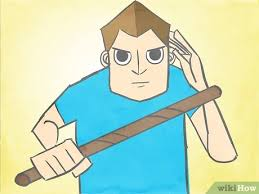
The titles of the below sections are taken from the grading sheets in Jan de Jong: the man, his school and his jujutsu system (Jan de Jong Self Defence School, 1997).
Breakfalls (Ukemi)
Bridgefall, and backwards flat, sideways flat, forwards roll, sideways roll separately over an obstacle.
The bridge fall, aka o mae ukemi, is the same as in the previous grading.
While responding to a comment on my Facebook post sharing the previous blog post, I remembered that I neglected to explain why sideways roll is so uncommon in the martial arts. It's because most ukemi comes from judo and there is no need for a sideways roll from judo techniques.
I was also reminded that there are some (aikido) that teach a backwards roll that starts to resemble a Jan de Jong (JDJ) sideways roll. That is true, but it is more of a backwards roll than a JDJ sideways roll, however, having said that, it is worth noting because a JDJ sideways roll transitions into a backwards roll.
This is one of the aims of these series of posts, if not this entire blog, and that is to encourage those engaged in martial arts to engage in critical thinking, to seek insights that produce a new and better understanding, rather than just teaching and training what is taught.
For progression, the o mae ukemi could have been performed over an obstacle in this grading. There is a 'trick' to performing o mae ukemi over an obstacle.The trick to performing o mae ukemi over an obstacle, I discovered by observing John Poulton (ikkyu) in the instructors class way back when. John Poulton is front left, beard, in this photo taken from the JDJSDS Yearbook 1986 - Hakusho. He was performing o mae ukemi over obstacles when none of the other instructors pictured could and ever did. It is simply a forwards roll that you don't come out of; a forwards roll terminating in a backwards flat. :)
There is a lot of history in that photograph. Do the current JDJ ryuha know and study that history and share it with their students? Who can name all in the photograph and their legacy? This blog is about preserving and understanding the history of the JDJ tradition.
Wakai no Kata
You will recall from the 'Historic Ikkyu Part 1' post that JDJ developed wakai no kata to replace Yoseikan Budo's (YB) happoken and sanbogeri. He then moved the kata to nikyu and included it in 7th kyu, the last of the mon grades before the kyu system. Happoken taught blocking and striking skills and sanbogeri taught kicking skills. JDJ's wakai no kata is designed to teach blocking, striking, and kicking skills.
The issue of using a block in conjunction with an evasive body-movement (EBM) that was discussed in a previous post is present in this kata.
Last year I saw a JDJ ryuha yudansha demonstrate this kata while teaching it to their students. I would fail that performance if a grading candidate presented it for their 7th kyu grading, let alone a yudansha that has supposedly performed it in two gradings.
JDJ's wakai no kata includes pencak silat's depok and sempok stances. Same stance but looking forward or backward. It is an extremely versatile stance in terms of an EBM and setting up for strikes, kicks, and unbalancing.In the abovementioned performance, the performer did not perform the stances correctly (or simply did not know how to do so), which nullified their tactical effectiveness.
Then of course there was the issue that the kicks were poorly executed, wafting upwards rather than 'shooting' in and out, and the timing of the defensive combinations was all wrong. Basically, it was a blur from start to finish interrupted only by the performer being unbalanced when performing the depok and sempok stances.
These issues were also common with the performances within the Jan de Jong Self Defence School (JDJSDS), including that of most of the instructors.
The abovementioned JDJ ryuha refers to this stance as a 'cross stance' (kosa dachi). That is a reference to a Japanese karate stance which is 'similar' to the pencak silat depok and sempok except that karate does not realise or understand the potential of this stance.I attended a seminar co-jointly hosted by Wally Jay and George Dillman while I was living in London. Dillman was on the pressure point bandwagon at that stage, but he also presented his 'study' of karate kata which included a Shotokan kata where this stance is performed. He explained that this stance is entirely useless but that it was a 'secret' of the kata because it was part of a turning move when executing what the JDJ tradition knows as hachi mawashi (hair-chin turning). When Dillman asked what is the point of this stance before his 'explanation', I wanted to put my hand up and say that it was a major feature of a very effective martial art taught to one of the most populous nations on the earth, but I didn't.
Throwing Techniques (Nage Waza)
This is the first time in the mon system that throwing techniques have been introduced. There are four throwing techniques from specified attacks: single lapel grip (low) - hip throw; single lapel grip (high) - shoulder throw; low punch - minor inner reaping; and low punch - minor outer reaping.
Body Movements (Taisabaki)
'Defender's choice of attack, using any block.'
The issue of 'blocks' and the demonstration of these body-movements as defences has been discussed in previous posts.
All five of YB's basic body-movements are included in this section, along with dodging (kawashi).
The dodging body-movement was included in this grading due to Greg Palmer's lobbying. I argued that dodging was simply a variation of either flowing or sliding body-movements, which I went on to demonstrate in my taisabaki no kata grading in sandan. It was a 'teach the teacher' moment, however, even though they agreed with me, it is still retained in this grading.
To challenge the reader's understanding of this body-movement that they are either training and grading or teaching, is the dodging body-movement as taught a variation of flowing or sliding? Even though JDJ used a dodging body-movement often in his demonstrations, why and how is it different to the one included in this grading? Also, identify the defences in the kyu and dan grades where this dodging body-movement is used in a defence.
Unbalancing (Kuzushi)
Normal single wrist grip - Normal and same side unbalancingReverse single wrist grip - Reverse and same side unbalancing
Same side single wrist grip - Normal and same side unbalancing
The unbalancing from single wrist grips is taken straight from YB, however, JDJ is building on YB's teachings. What is JDJ trying to teach/impart with the two forms of unbalancing from the same single wrist grip? Did the instructors (a) understand this lesson, and (b) teach this lesson along with the techniques?
In his later years, JDJ was teaching this lesson and referred to kuzushi and hazushi for the two types of unbalancing. Hazushi means disengagement or release according to the glossary in Jan de Jong: the man, his school and his jujutsu system (Jan de Jong Self Defence School, 1997).
The basic idea is that with normal and reverse unbalancing, the captured hand is disengaged whereas with same side unbalancing it is not. This then facilitates one of the nine basic joint-locking techniques taught by the JDJ tradition and which is demonstrated in the mon grades. Same side unbalancing does not necessarily disengage the hand grip, turns the elbow up, thus facilitating straight arm lock, side wrist lock, and wrist crust. Normal and reverse unbalancing disengages the hand grip and keeps the elbow down thus facilitating the other six joint-locking techniques.
This is a valuable and sophisticated lesson in versatile tactics, a unique one developed by JDJ, that is often not understood within the JDJ tradition. This leads to the question, should it be included in the relatively lowly grades of the mon system?
Locking Techniques (Kansetsu Waza)
'Two attackers defender's choice of attack.'
The issue of the appropriateness of this stress element in these early gradings has been discussed in numerous pervious posts in this series.
The three kansetsu waza in this grading are arm entanglement (ude garami), side wrist lock (yoko tekubi hishigi), and wrist hand throw (tekubi te nage). The latter two are known by different names in aikido. This completes the nine basic kansetsu waza taught within the JDJ tradition.Basic Blocks and Attacks (Uke and Atemi)
Three punches and one kick - four basic karate-style blocks.
There is no unbalancing - blocking section as included in 9th kyu.
These blocks are often taught in conjunction with an EBM. As has continually been questioned in numerous posts, e.g., The Mon System and Blocking Techniques, what is the purpose of the block when used in conjunction with an EBM. It's not to avoid injurious contact with the body because the EBM takes care of that problem. This is a question that should be asked and answered as it would demonstrate insight and understanding.
The defences in this section include a karate-style block followed by a punch. This should be taught as an alternative to the singular use of EBMs, or just avoiding an attack. It would be a useful tactic to employ in the free fighting gradings of ikkyu and the dan grades.
Reflex (Shinken Shobu no Kata)
Fifteen defences from holding, strangulation, punching, kicking, stick, and knife attacks. There are two 'restraining techniques' included in the 15 defences, which is to say a pre-emptive application of a joint-locking technique.
All of the defences have been demonstrated in this or previous gradings, as they should be.
There is a 'stick-overhead attack.'This was also a common fault in the JDJSDS.
The lesson to be learned here is to teach the students how to attack properly first, and then teach the defence.
This was something lacking in the JDJSDS as well.






No comments:
Post a Comment